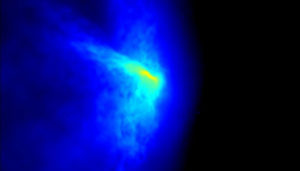Gas flows in the early universe may have kept clouds from collapsing too soon, enabling them to grow into massive black hole seeds.
Oodles of supermassive black holes exist in the universe. We see the glow of their superheated gas tutus all the way back to the first billion years of the cosmos, and the masses we infer from those glows are amazing: billions of times the mass of the Sun.

Shingo Hirano
One of the big questions astronomers are currently grappling with is, how did the first giant black holes form? I explored this question in depth in our January 2017 cover story, but to give you the short version: either they started small and beefed up really fast, or they started big.
The second pathway is called direct-collapse. In this scenario, an abnormally hefty cloud of gas is able to collapse into a black hole of roughly 10,000 solar masses (perhaps temporarily shining as a supermassive protostar along the way). In order for this to happen, the cloud has to avoid fragmenting into smaller clumps as it collapses—which is what it would usually do. One way to evade fragmentation is for the gas to stay the same temperature as it contracts, a process called isothermal collapse.
The main way astronomers make this happen in their simulations is by having a lot of young stars near the cloud. Their ultraviolet radiation would break up any molecular hydrogen in the cloud, and because molecular hydrogen helps cool gas, the cloud won’t chill so fast that it breaks up. However, the caveats that come with this scenario make some astronomers squeamish.
Following up on previous work, Shingo Hirano (University of Texas, Austin, and University of Tokyo) and colleagues took a different approach: they put the clouds in environments where gas is moving at supersonic speeds.
These whooshing flows would have existed in the early universe due to conditions in the first few hundred thousand years of cosmic history, before the universe cooled down enough for light and matter to separate. In that primordial plasma soup, dark matter started lumping up gravitationally, but the baryons and photons interacted with each other and resisted the pull. The resulting backlash created flows. When the universe later cooled down, the speed of sound dropped below the speed of these flows, making them supersonic by default.
Reporting in the September 29th Science, Hirano’s team found that the supersonic gas streams keep clouds from condensing as early as they normally would. Thus, the clouds are able to grow a whole lot bigger before gravity overcomes the motions and triggers the initial collapse to a protostar —and then, potentially, a black hole of tens of thousands of solar masses.
It’s still unclear how common fragmentation would be in these situations. Plus, the supersonic streams approach doesn’t create perfectly isothermal conditions. However, recent work by Muhammad Latif (COMSATS Institute of Information Technology, Pakistan) and Marta Volonteri (Paris Institute of Astrophysics) suggests that collapse doesn’t have to be exactly isothermal in order for massive objects to form. Thus, the new study adds another avenue — in addition to the ultraviolet scenario — that astronomers can investigate as a way to form the seeds of the universe’s supermassive black holes.
References:
Shingo Hirano et al. “Supersonic gas streams enhance the formation of massive black holes in the early universe.” Science. September 29, 2017.
 0
0









Comments
You must be logged in to post a comment.